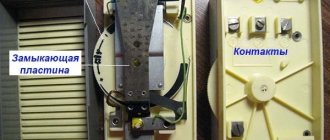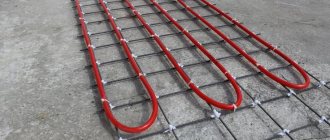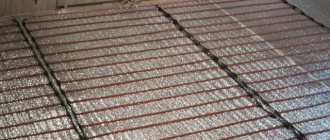Any engineer will confirm that without a thermostat (TR), the “warm floor” heating system (TP) will not be able to function. And if it is chosen or configured incorrectly, even the most high-quality system will perform the job ineffectively, the house will be cold, and energy bills will be “astronomical.”
Today, the climate control equipment market is oversaturated with proposals for technical solutions for TP of Russian and Western production. Many buyers have no idea which thermostat to choose for a heated floor, so that it takes into account all the operating conditions of the heating system as much as possible. Although in reality everything is not so complicated, the main thing is to know the algorithm for choosing the right device.
Why do you need to install a heat regulator for a heated floor?
The thermostat in the heated floor system provides automatic adjustment of thermal conditions and protection of the system from emergency situations. In fact, it is a control panel for an in-house heating system that can provide the most comfortable living conditions with minimal energy consumption.
Installing a TP in a heating system allows users to organize:
- Weather-dependent thermal control based on outside air temperature. Due to the fact that thermal processes have a certain inertia, it is better to perform the adjustment according to the climatic characteristics on the street outside the window of a house or apartment.
- Up to 50% energy savings during the heating season: gas for water heating stations and electricity for electric heating stations. For electric heating, savings can be even greater if the owners transfer subscription metering to a multi-zone electric meter and the main heating is carried out at night.
- Ensure 100% protection of the residents and property of the house from an emergency in the TP system.
- Perform remote control of the process using ordinary smartphones. This allows you to select and control heating modes while being at a considerable distance from home.
Mechanical temperature sensor
A mechanical thermostat does not have an electronic display or other components. Installing a mechanical thermostat requires a little knowledge and time, since the STP is connected to the sensor by connecting electrical wires.
A mechanical thermostat consists of a switch and a rotating temperature control axis. A switch allows you to turn off the energy supply to the heated floor without resetting the settings.
The thermoregulation mode occurs due to a metal plate made of two metals, connecting two wires to each other in a state of rest (cold plate). When heated, the plate bends, stopping the flow of current from one contact to another, thereby cooling the system.
The advantages of a mechanical thermostat include:
- Affordable price;
- Ease of use;
- Working in a room with low temperature;
- Strength, safety;
- Tolerates sudden temperature changes well;
- Long service life;
- It turns on automatically if the electricity is turned off and then back on.
Despite their simple design, mechanical thermostats are popular due to their safety, reliability and ease of use.
Operating principle of the thermostat
The operating principle of the TP is to close/open the electrical circuit when the temperature inside the room reaches a set value, measured by the primary temperature sensor. At this moment, the electric relay is activated, and the TR turns on/off the voltage supply to the heating elements. In the case of using water TP systems, the command is sent to the gas shut-off valve, which regulates the gas supply to the boiler.
As a rule, in such regulators the deviation from the set mode is 1 °C. This indicator provides hysteresis of the thermostat. It is different for each TR model and is set by the companies that produce the devices. Nowadays, modern TRs have the ability to fine-tune the hysteresis to the benefit of the user.
TR modifications for “warm floor” systems
On the market today there is a huge number of thermostats, both domestic and Western brands, for different operating conditions.
The choice of TP for heated floors must be made taking into account the existing classification. All TR are classified according to several indicators:
- according to installation option: overhead type and built-in, for example, in a socket box;
- according to the method of reading and regulating temperature: mechanical - the most budget option, with built-in water or gas-filled bellows. They do not have high accuracy; they have a large temperature hysteresis ± 3 °C. During operation they make loud clicks, and energy savings are no more than 15–20%;
- electronic-mechanical - mid-price range, with a built-in thermocouple. More accurate devices with a hysteresis of 1 °C. Capable of providing energy savings of no more than 30%. They have a low control range. There are no night and day setting modes;
- programmable and digital temperature controllers. Fine adjustment is ensured by temperature hysteresis from 0.2 to 0.5 °C. They have a self-diagnosis system, remote control and weather-dependent settings. Capable of providing heat savings of up to 50%. Today this is the best option for a “warm floor” system;
Step-by-step installation instructions
For the thermostat to work and accurately determine the temperature, it is not enough to choose it correctly; it is also important to install the device correctly. Installation usually does not cause problems, but we decided to clearly explain this.
Regardless of which regulator you decide to install, you should start by choosing a location for it. It should be convenient to use. It is necessary to calculate so that the device is located close to the sockets and doors, the height from the floor is 1.5 meters. It cannot be mounted near a window.
Usually, the thermostat kit includes instructions that you need to read.
Sequencing:
- Before starting work, the installation site is de-energized;
- the wires from the heated floor must already be connected to the socket box;
- then the sensor is installed - it is placed in a corrugation, one end is brought out into the socket box, and the second is located between the heaters (cable or infrared film floor plates);
- insulation is removed from the floor wires - 6 cm;
- the cable screens are connected to the yellow-green wire, then everything is placed in the socket box;
- the top panel of the thermostat is removed - you need to insert a straight screwdriver into the groove from below, pressing the lid will snap off;
- the floor wires are connected to the required terminals of the regulator according to the diagram;
- the wires are carefully bent, the device is inserted into the socket;
- the frame is installed and the top panel is attached.
The floor heating thermostat is connected, all that remains is to check its operation.
How to choose the right thermostat
The most important indicators that need to be taken into account when choosing thermostats for heated floors are: electrical network, thermal power, type of control and temperature sensor.
With the introduction of the Smart Home system, additional functions such as:
- Lock from unauthorized activation or child protection - you cannot change the preset TP settings;
- work without a sensor. It is also called partial power mode, where users chose the time of the warm-up start and stop cycle of the energy carrier;
- remote control of indoor heating via the Internet.
Important! Before choosing a thermostat for existing equipment, you need to know its permissible electrical characteristics and dimensions, according to the equipment’s factory instructions.
By type of electrical network
The type of network depends on the selected energy carrier: water/electricity. The latter will require a large electrical load. In addition, the operating principle of these regulators is significantly different. In the first option, the water temperature of the internal heating circuit is controlled, and the control command is sent to the circulation pump and the gas shut-off valve on the boiler.
And in the second version of electric heating, the main role in selecting a modification is played by the power of the cable heating and the amount of load current for which the heating device is designed.
Reference. Today, there are universal types of thermostats on sale that can operate in two systems, but they are more expensive and are rarely used because they require combined heating circuits - “water-electricity”.
The type of network is determined by the input parameters at the input to the controller. The electrical load on the networks during electric heating will be significantly higher than in water-based “warm floor” systems, where thermostats with a current load of up to 3 A will be sufficient.
In the case where the house is designed for electric heating with electric cables, the minimum threshold for installing thermostats should be a current of at least 16 A.
Important! The distribution zones of electric heating circuits per thermostat should not exceed a power of 2000–2500 W. It is recommended to install different regulators for different temperature zones: in living areas, in the kitchen and in the bathroom.
By type of control
The most affordable ones are mechanical. They, similar to electro-mechanical ones, have manual control. The desired temperature of the internal air in the room is set on the scale. Their regulation system is quite simple and there are no additional functions.
For example, if the regulator presets T = +20 °C, when it is reached, the floor heating will be automatically turned off. After natural cooling in the room, in accordance with the temperature hysteresis of 1 degree, at T=+19 °C, voltage will be applied to the heating elements.
A good digital electronic regulator belongs to the middle price range. They are well represented on sale by domestic, Chinese and Western European models. Setting modes are set using buttons or on the touch screen. The LCD display shows the current temperature and can diagnose the operation of the thermostat. The system has a built-in timer that allows you to set a special heating mode according to the hour of the day and day of the week. It is better to choose a weekly setting. Temperature control is carried out by both built-in and remote sensors.
Innovative electronic programmable temperature controllers have a wide control range and fine settings that allow you to maintain the highest quality temperature in the room with minimal specific energy consumption. The thermostat can offer the user many pre-configured control modes: anti-freeze, vacation, daily, weekly and many others.
The thermostat itself switches from “winter” to “summer” mode and remembers all user settings. The touch screen and well-thought-out interface allows the user to set up complex modes without any help and connect it to the Smart Home system.
By power and load
The most difficult operating conditions for TP are in electric heating systems; in this case, it must be selected with a margin of at least 30% of the heating power of the heating cables in the corresponding circuit. In this case, both the rated current of the thermostat and the supply voltage must be taken into account.
By temperature sensor type
In order to choose the right thermostat for a heated floor, it is very important that it is compatible with the purchased temperature sensor. When purchasing these devices, you need to read the product data sheet, which details the areas of application and types of acceptable primary meters.
There are models with built-in temperature sensors; they are sensitive to the installation location. Thus, their installation is not allowed near heating devices, under directed sunlight and in drafts, so as not to create an error in the operation of NTC sensors.
The operation of remote models of temperature sensors is practically not affected by local conditions, since they are placed in an insulated protective tube housing, between adjacent heating elements and in the thickness of the “warm floor”.
For powerful heating systems and for wooden floors, combined-action thermostats are installed, which work simultaneously with air and floor temperature sensors.
Important! An external temperature sensor measures the temperature of the floor, and therefore, when performing adjustment work, you will need to additionally take into account the thermal characteristics of the coating: parquet, laminate or tile.
By installation method
A user who independently completes a kit for installing a TP system should pay attention to the option of installing temperature sensors so that they are conveniently located in the room and are accessible for control and adjustment.
There are several options for mounting the TR:
- Invoices are located in a special case on the wall. This option can be applied to all types of wall building materials.
- Built-in - installed in a factory mounting box. To install it, you will need to additionally knock out a hole in the wall and make grooves for laying cables. This option is not allowed for placement on wooden walls.
- Connection on a DIN rail in the switchboard panel, which is not very convenient when setting modes is performed quite often.
Tips for choosing
Before purchasing, we suggest that you familiarize yourself with the main criteria for choosing thermostats:
- Type. There are mechanical, electromechanical and digital. They are selected based on the future purpose and operating conditions.
- Maximum load. It is taken into account depending on the number of heaters in your heating system.
- Size. There are compact, large and large.
- Temperature range. Different models support temperatures from -60 to 1200 °C.
Popular thermostat models
The rating of popular thermostats is compiled by large trading platforms based on consumer demand, taking into account consumer reviews and the opinion of the expert community. It helps potential buyers choose the right model.
According to the latest results, the rating of thermostats looks like this:
- Nest Learning Thermostat 3.0, cost RUB 16,500.
- Caleo 520, cost 3,520 rubles.
- Electrolux ETT-16 Touch, cost 4,468 rubles.
- DEVI Touch, cost RUB 5,839.
- Terneo SX, cost 4,670 rubles.
- Teplolux TR, cost 4,467 rubles.
- Grand Meyer HW500, cost 1,066 rubles.
Nest Learning Thermostat 3.0
The third generation thermostat, although outwardly practically no different from its predecessors, has new modern functions. Features a stylish look in the black, sophisticated Ecobee3 design. The diameter of the round display is increased to 18 cm and has a resolution of 320x320 pixels.
The regulator has a modern set of functions: programming, auto-scheduling, auto-shutdown, emergency signaling of the heating system and modern forms of control, including remote control via Wi-Fi. Users cite the advantages of the model as: a large screen, precise control, clear settings and an excellent diagnostic system. The only disadvantage of TR is its high price.
Caleo 520
Digital Russian regulator with touch control, made with a surface-mounted type. The thermostat is equipped with an LCD display on which the heating temperature is displayed; thanks to it, setting the thermal mode is quite simple, which simplifies the operation of thermal and electrical equipment.
The operating temperature range of the TR is within 0–40 °C. The connection between the regulator and the “warm floor” cable system is wired. Russian users appreciated the low price and modern design of the regulator. In addition, the advantages of this model include touch controls with locking and low power consumption. The disadvantages of its owners include the noisy operation of the relay.
Electrolux ETT-16 Touch
Installed for systems with a high load level of 3.6 kW. The hidden-mounted device has a special dust-repellent screen and a programming function for 7 temperature settings for each day of the week.
The LCD touch screen constantly displays indicators of the internal air temperature, the state of the heating system and the current time. Users liked this controller for its significant energy savings on heating, modern touch controls and accurate settings with weekly programming. Its disadvantage is that the manufacturer did not include a description of the error codes in the regulator instructions.
DEVI Touch
A device for high-performance heating systems, capable of carrying a load of 3.68 kW. Compatible with many temperature sensors. Thermal conditions in the heating system are controlled by a microprocessor control unit in the range of 5–45 °C. The device has a large touch screen and is equipped with modern options: anti-freezing, standby heating in the absence of residents and an open window detection function.
The owners of such a regulator include the quality of the screen with simple settings, provided by modern visualization of the process, a multifunctional operating mode and real savings on heating costs when installing it. The disadvantage is the uninformative instructions, which do not explain in detail all the subtleties of installation. For example, there is no wiring diagram.
Terneo SX
Electronic thermostat with touch control and remote control via Wi-Fi. The manufacturer offers users the Terneo cloud for storing settings and conducting statistical analysis of the operation of the heating system in order to compare selected modes. The mobile application can work with different operating systems, both on PCs and on tablets and phones. Installation is internal, in a special box.
Users note the following advantages of the model: stylish design, extensive functionality, precise temperature control, ease of control and real energy savings. Disadvantages include low-quality plastic and incorrect operation of the software.
Thermostats are mandatory devices for regulating heating processes installed in a “warm floor” system. They can be either mechanical or modern programmable.
A user who has chosen a “warm floor” heating system must take care in advance about choosing the type of thermostat. Its decision may be influenced by the price level, accuracy of settings and energy savings in heating systems. The best thermostats are programmable; they can provide the greatest cost savings (up to 50%) during the heating season.











